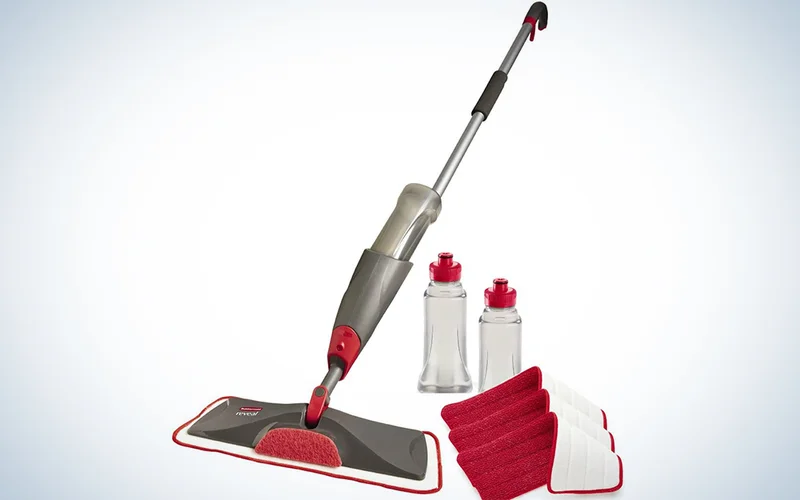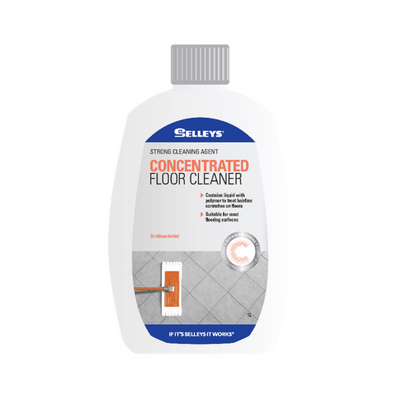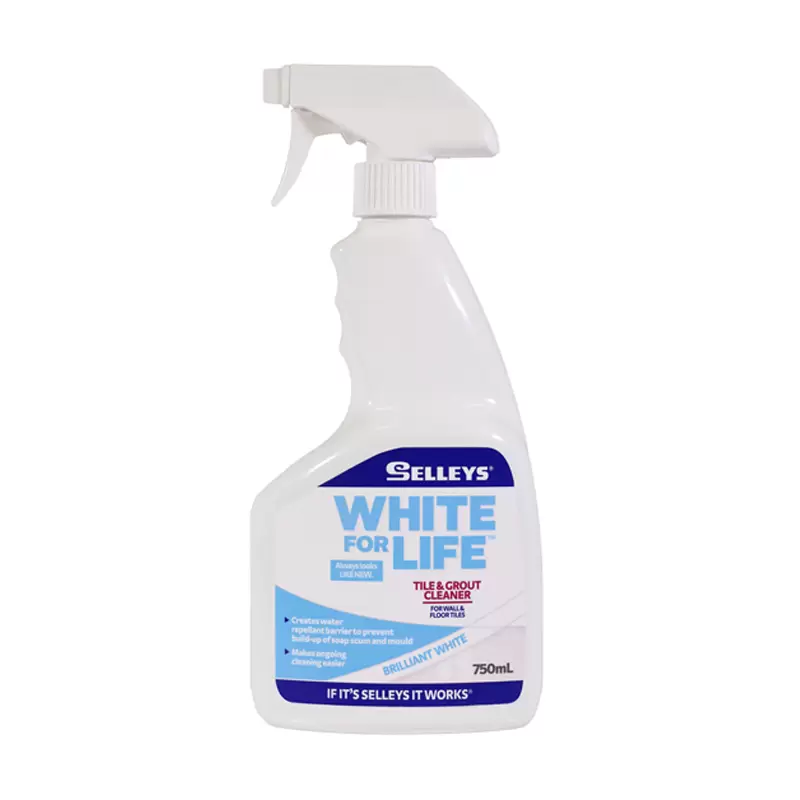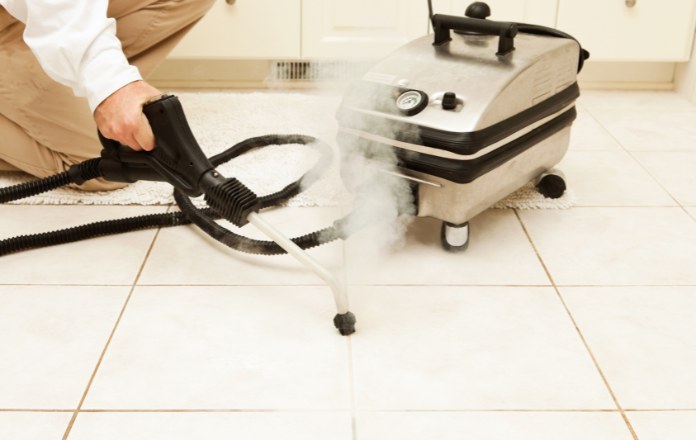Toilet floors are one of the most frequently overlooked areas when it comes to cleaning. Some people may think that a quick rinse would suffice, but does it?
If not cleaned and dried thoroughly, bacteria and allergens can accumulate, and mould may grow. As a result, your bathroom may become unsightly and unhygienic.
In this guide, we show you how to clean the toilet floor in 4 easy steps with some tips and things to avoid. We also share the methods for removing stains and how to go about cleaning grout.
Table of Contents
How To Clean The Toilet Floor
Before you start, you’ll need to get some cleaning supplies ready.
What you need:
- Broom or vacuum
- Mop and pail
- Floor cleaner liquid
- Water
Once you have all the tools and supplies you need, follow these 4 simple steps to clean your toilet floor.
Step 1: Remove items lying on the floor and sweep the area
Remove loose objects such as toys and hair ties from the floor. Next, give it a sweep and remove hair from the floor trap.
Note!
It’s best to ensure that the floor is dry before sweeping. This makes the task easier as dirt and hair are less likely to stick to the floor.
Step 2: Mop the toilet floor
After sweeping the floor and ensuring that it’s free of loose objects, it’s time to start mopping!
You can choose between 2 types of cleaners: commercial and homemade cleaners.
Commercial cleaners like Selleys Concentrated Floor Cleaner
When choosing a floor cleaner, it’s best to pick one that’s suitable for the type of flooring you have. Some cleaners are versatile and can be used for many types of flooring.
One such example is Selleys Concentrated Floor Cleaner, which is suitable for tiles, marble, wood and polished concrete, among many others.
This anti-bacterial solution can stamp out grease, grime, and odours. Its non-sticky, non-slippery, pH7-balanced formula is suitable for households with pets and children. With this cleaner, your toilet floor will be left with an added shine.
Simply mix 60ml (2 caps) of the cleaner with 4 litres of water to create the cleaning solution.
Note!
If you have natural stone floors, avoid using acidic cleaners or cleaners containing bleach. Acid may corrode the floor’s surface and bleach can weaken the material over time.
Homemade cleaners
If you prefer using a cleaning solution with fewer chemicals, you can make a homemade cleaner. Simply mix 236ml of white vinegar with 3.7 litres of water to create your own cleaning solution. It can get rid of dirt and grime, and eliminate mould and mildew.
Step 3: Rinse the floor
After mopping the toilet floor, rinse it with some water. This will get rid of any remaining cleaning solution.
Step 4: Leave the toilet floor to dry
Allow the floor to air dry for 5 to 10 minutes. You can speed up the drying process by ensuring proper ventilation in the bathroom.
How To Clean Tile Grout
Grout is found in the slight indentation between tiles and tends to collect dirt, hair and other small particles easily. At times, simply sweeping or mopping the floor may not be sufficient to keep your grout clean.
Additionally, dirty water and other liquids may seep into unsealed grout. As a result, the grout may look unsightly, and mould may grow over time.
If you would like to know how to clean grout, follow these steps below!
What you need:
- Grout cleaner
- Hard bristle brush
- Water
Step 1: Grab a grout cleaner
When choosing a grout cleaner, remember to read the label carefully. Ensure that you purchase one that’s safe for use on the surface you’re cleaning. For example, some products may only be suitable for coloured tiles, not white ones.
Selleys White For Life Tile & Grout Cleaner is an effective and gentle grout cleaning agent suitable for ceramic, glazed and porcelain tiles. This specially formulated anti-bacterial solution removes soap scum, soil, and salt crystals.
It leaves your grout with a protective, water-repellent layer that prevents dirt and debris from building up in future and also restores the natural shine of your grout and tiles.
Alternatively, you can make a homemade grout cleaner by mixing 1 part hydrogen peroxide with 1 part water until a smooth paste is formed.
Step 2: Use a hard bristle brush to scrub the grout
Spray (or spread) the cleaner over the grout and start scrubbing with a hard bristle brush.
Step 3: Let the grout cleaner sit before rinsing it off
Allow the grout cleaner to sit on the surface for at least 15 minutes before rinsing it off. You can leave the cleaner on longer for tougher stains.
How To Remove Stains From The Toilet Floor
At times, simply cleaning the floor isn’t enough to remove stains. Here are some methods you can try to eliminate tough stains.
Method 1: Vinegar
Suitable for: Vinyl flooring
Vinegar is a natural acid that can dissolve dirt, grime, and grease. Plus, it’s a great way of getting rid of stains.
What you need:
- Vinegar
- Water
- Spray bottle
- Sponge
Directions:
- Mix water and vinegar in a 1:1 ratio in a spray bottle.
- Next, spray the solution onto the stain.
- Scrub the stain with the rough side of a sponge.
- Rinse the area with water and dry it after.
Method 2: Lemon juice and vinegar
Suitable for: Wood and tiled floors
A diluted solution of lemon juice, vinegar and water cleans various stains, such as rust, grease, and coffee.
What you need:
- Lemon juice
- White vinegar
- Water
- Mop and pail
- Sponge (optional)
Directions:
- In a pail, mix lemon juice, white vinegar and water in a 1:1:2 ratio.
- Mop the floor using this solution. You may want to scrub the stain with the rough side of a sponge if the stain proves to be stubborn.
- Rinse the floor with water before drying it.
Method 3: Degreaser
Suitable for: Linoleum flooring, vinyl flooring, sealed wooden floorboards, and ceramic tiles
Degreasers can remove tough oil stains from your toilet floor.
What you need:
- Degreaser
- Sponge, cloth or paper towel
- Water
Directions:
- Spray some degreaser on the oil stain.
- Allow it to sit for 1 to 2 minutes.
- Wipe the area with a sponge, cloth, or paper towel.
- Rinse the surface with water to remove any degreaser residue and dry the floor.
Method 4: Steam cleaner
Suitable for: Linoleum flooring, laminate flooring, some hardwood floors, ceramic tiles, and porcelain tiles
Steam cleaners are useful for eliminating embedded stains and grease. They also sanitise the surface by eliminating bacteria, mould, viruses and allergens.
What you need:
- Steam cleaner
- Water
Directions:
- Fill up the steam tank with water. The amount of water to use depends on the capacity of the tank.
- Turn the steam cleaner on to heat it up.
- Use the mop head attachment to remove stains from flat surfaces and the nozzle attachment to clean corners.
Method 5: Castile soap
Suitable for: Stone, tile, hardwood, laminate and linoleum flooring
Castile soap is a gentle solution made from olive oil. It can lift grease and dirt, making it suitable for stain removal. Additionally, it can be used in households with children and pets as it’s non-toxic.
What you need:
- Water
- Castile soap
- Spray bottle
- Scrubbing brush
Directions:
- Combine 473ml of water with half a teaspoon of castile soap in a spray bottle.
- Spray the mixture onto the stain.
- Work it into the stain by scrubbing with a brush.
- Rinse the mixture off and let the floor air dry.
Note!
Avoid mixing castile soap with vinegar. Castile soap is alkaline in nature and will neutralise acids like vinegar, making both cleaning agents less potent. Moreover, this mixture may create a white film on the surface which can be difficult to remove.
Method 6: Bleach
Suitable for: Linoleum flooring and tiles
Bleach effectively eliminates traces of bacteria, fungi, and mould from the floor. It can also remove oil stains and brighten the surface.
What you need:
- Gloves
- Bleach
- Water
- Spray bottle
- Brush or sponge
Directions:
- Put on a pair of gloves to prevent skin irritation.
- Combine 20ml of bleach with 1 litre of water and transfer the solution into a spray bottle.
- Spray the solution onto the stain and leave it for 1 to 2 minutes.
- Scrub the stain with a brush or the rough side of a sponge.
- Rinse the surface with water before drying it.
Note!
Bleach is a strong chemical that shouldn’t be used on porous surfaces such as marble and wood. Using it regularly will cause the surface to wear out over time.
Method 7: Oxalic acid
Suitable for: Marble flooring
Oxalic acid doesn’t just remove stains from marble floors – it also preserves the surface by forming a protective coating on top of it.
What you need:
- Gloves
- Hot water
- Oxalic acid crystals
- Spray bottle
- Toilet brush
- Water
Directions:
- Before starting, put on a pair of gloves.
- Mix 100ml of oxalic acid crystals with 1 litre of hot water. Be sure to mix well.
- Transfer the mixture into a spray bottle and spray the solution on the stained area.
- Next, scrub the stain with a toilet brush.
- Allow it to sit for 1 to 2 hours to penetrate the stain.
- Rinse the floor to remove any acid residue and dry the floor.
Tips For Cleaning The Toilet Floor
Here are some tips to keep the floor and your skin safe while cleaning.
Test the solution on an inconspicuous area
When using a cleaning solution or stain remover for the first time, it’s best to test it on an inconspicuous area first. If the solution isn’t suitable for your floor, the damage will then be limited to a small, hidden area.
Once you’ve confirmed that the solution is safe for the type of flooring you have, you can clean the rest of the floor with it!
Ensure proper ventilation
Turn on the fan or leave the toilet doors and windows open while cleaning to promote ventilation. Proper ventilation speeds up the drying process and prevents the inhalation of chemical fumes released by cleaning agents.
Wear gloves
We recommend wearing gloves when handling harsh chemicals such as bleach and oxalic acid to prevent skin irritation and chemical burns.
You may also want to wear gloves when squeezing the yarn of the mop. Gloves can protect your hands from germs, bacteria and potential allergens.
What To Avoid When Cleaning The Toilet Floor
Though cleaning the toilet floor may seem easy, there are some potential pitfalls. Here are some things to avoid when carrying out this chore.
Cleaning only the dirty parts of the toilet floor
To speed up the process, you may be tempted to only clean what you can see. However, many germs and bacteria cannot be seen with the naked eye. Thus, it’s best to clean the whole floor thoroughly to prevent you and your loved ones from falling sick.
Mixing chemicals
Combining chemicals such as ammonia and bleach to create a stronger cleaning solution is dangerous. The mixture can produce toxic gases like chloramines, and exposure to these gases can result in adverse bodily reactions.
Using harsh chemicals on tiles
Though harsh chemicals may seem like the best way to eliminate tough stains, they may cause your flooring to wear if used regularly. Instead, try using milder methods such as a diluted vinegar solution, lemon juice or castile soap to remove stains.
FAQs About Cleaning The Toilet Floor
How often should I clean my toilet floor?
We recommend cleaning the toilet floor at least once a week to prevent germs and bacteria from accumulating.
What is the best detergent for cleaning floors?
The best type of detergent depends on the type of floor you have. Selleys Concentrated Floor Cleaner is suitable for cleaning various surfaces including marble, tiles and vinyl. Its pH7 formula can eliminate grease, grime and odours easily. Moreover, it doesn’t leave a sticky finish.
Learn how to clean your vinyl flooring or marble flooring with our guides here!
How do I clean hair off the toilet floor?
You can use any of the following tools to get rid of hair on the toilet floor:
• Dusting mop
• Vacuum with a floor attachment
• Broom





